【二轮三轮复习必备】《名师一号》2011届高三英语二轮 三轮总复习重点突破第八节 特殊句式
文档属性
| 名称 | 【二轮三轮复习必备】《名师一号》2011届高三英语二轮 三轮总复习重点突破第八节 特殊句式 | 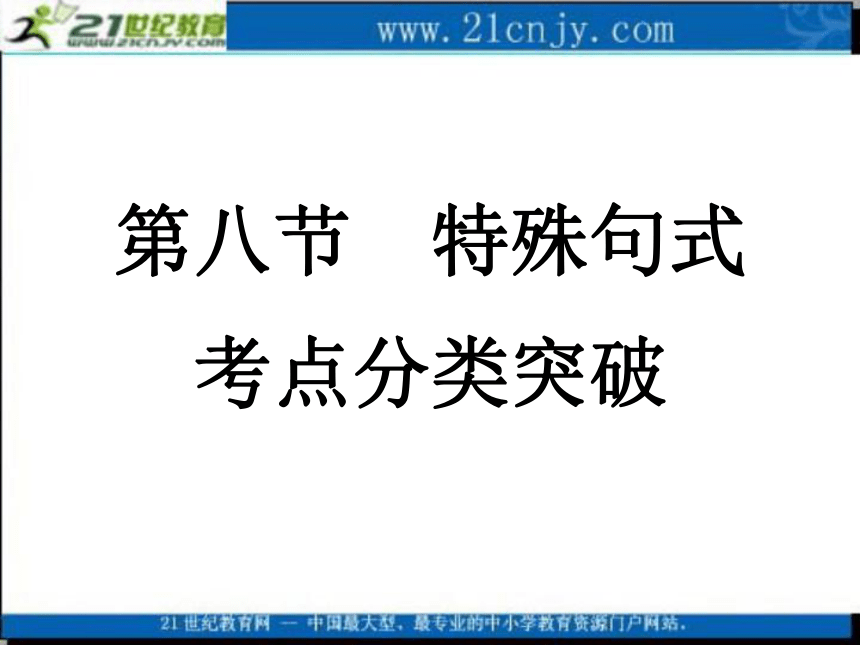 | |
| 格式 | rar | ||
| 文件大小 | 49.1KB | ||
| 资源类型 | 教案 | ||
| 版本资源 | 通用版 | ||
| 科目 | 英语 | ||
| 更新时间 | 2011-05-22 16:01:03 | ||
图片预览

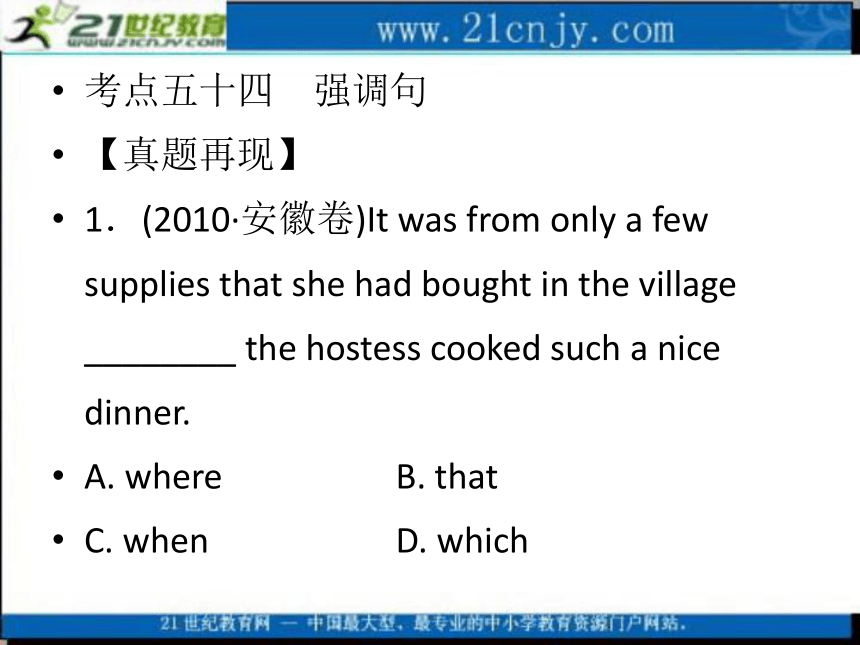

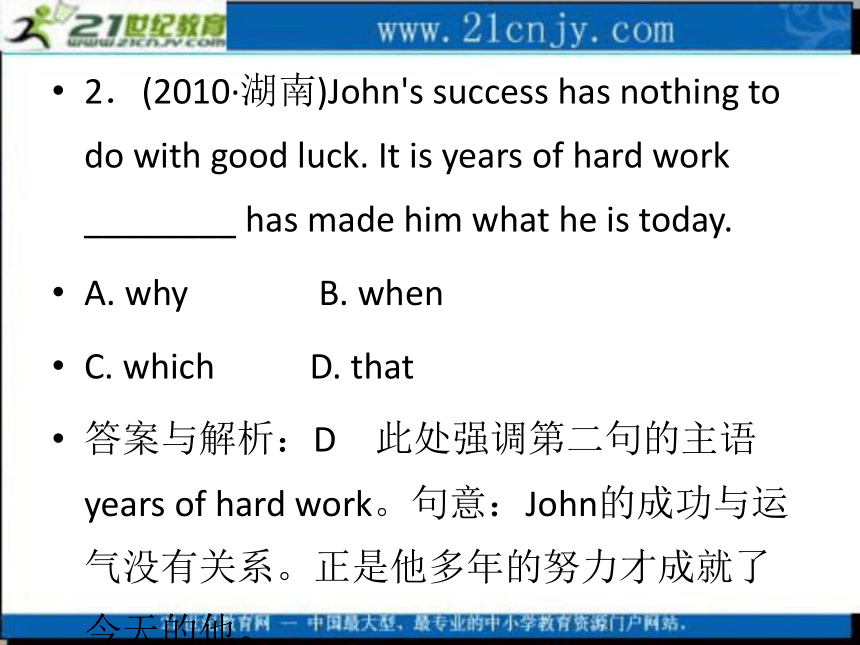
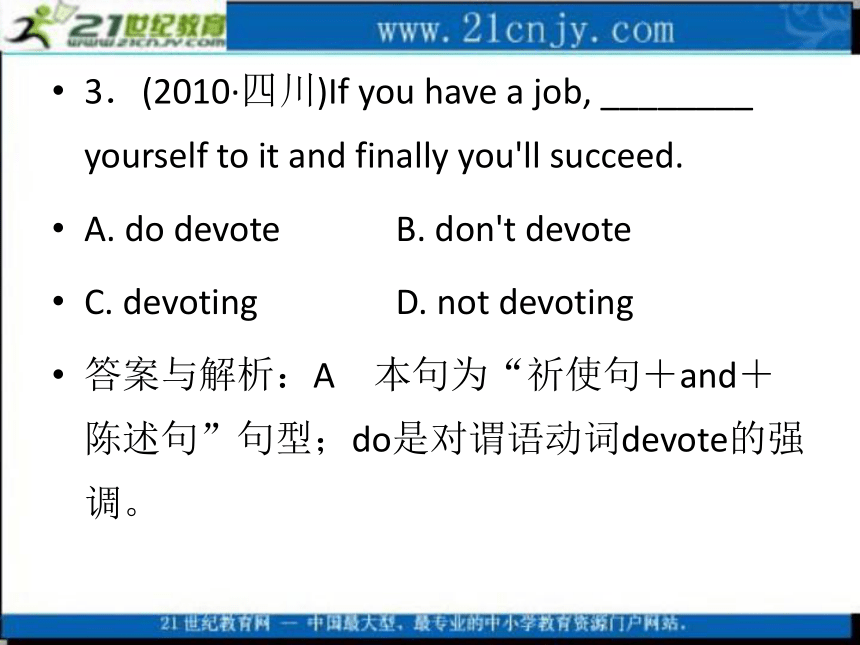

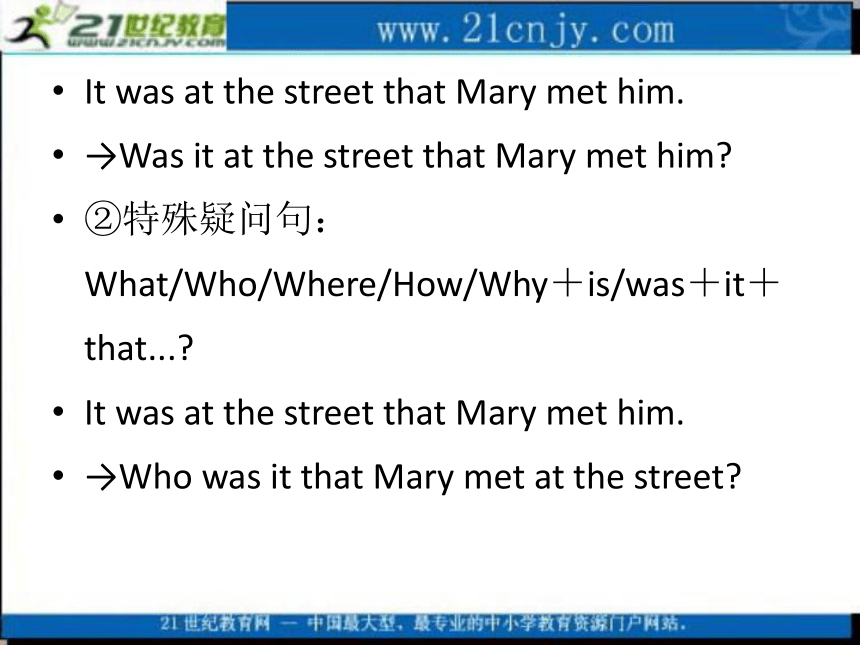

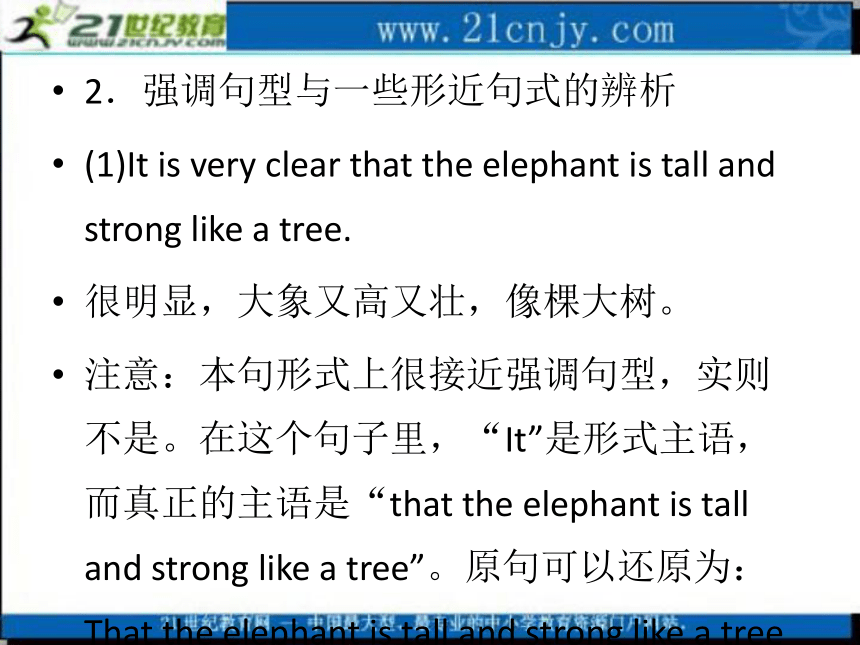
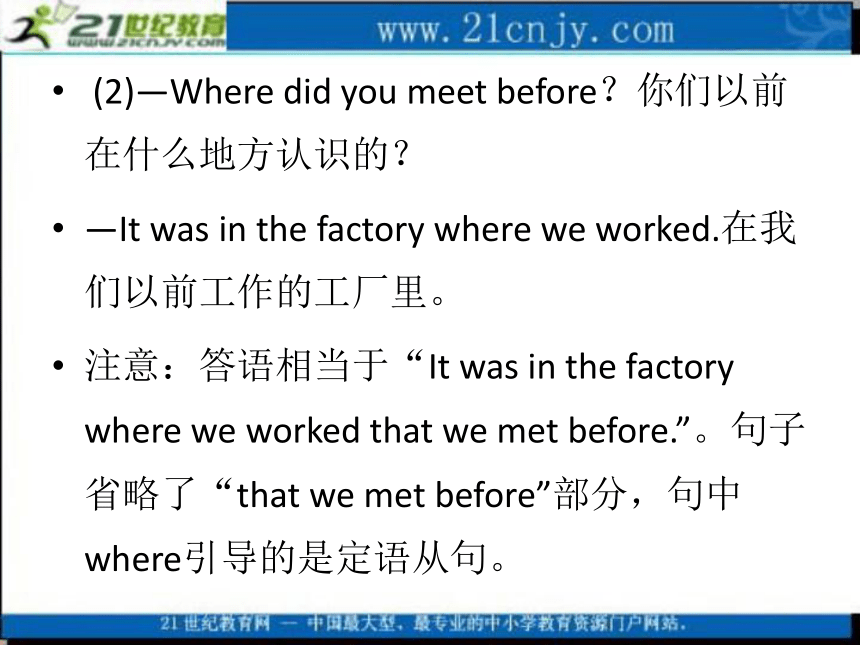

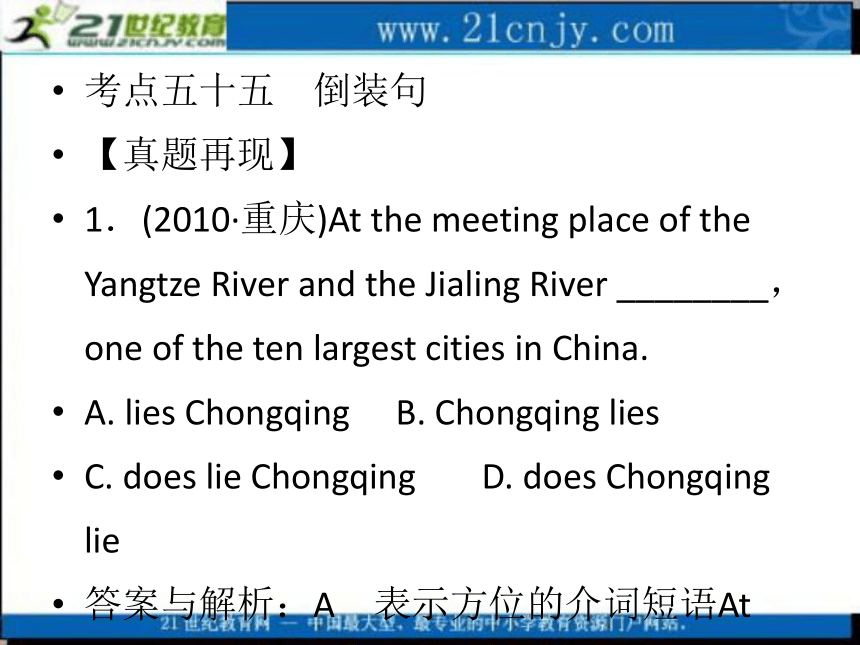
文档简介
(共41张PPT)
第八节 特殊句式
考点分类突破
考点五十四 强调句
【真题再现】
1.(2010·安徽卷)It was from only a few supplies that she had bought in the village ________ the hostess cooked such a nice dinner.
A. where B. that
C. when D. which
答案与解析:B 句意:女主人用先前从村庄中买的仅仅几样东西做出了如此美味的晚餐。被强调部分是from only a few supplies。句中的“that she had bought in the village”是定语从句,修饰先行词supplies。句子主干为the hostess cooked such a nice dinner。
2.(2010·湖南)John's success has nothing to do with good luck. It is years of hard work ________ has made him what he is today.
A. why B. when
C. which D. that
答案与解析:D 此处强调第二句的主语years of hard work。句意:John的成功与运气没有关系。正是他多年的努力才成就了今天的他。
3.(2010·四川)If you have a job, ________ yourself to it and finally you'll succeed.
A. do devote B. don't devote
C. devoting D. not devoting
答案与解析:A 本句为“祈使句+and+陈述句”句型;do是对谓语动词devote的强调。
【考点诠释】
1.强调句型的构成
(1)基本句型
It+is/was+被强调部分+that/who+其他成分
(2)强调句型的变化
①一般疑问句:将is/was提前,构成Is/Was+it+被强调部分+that/who+其他成分的形式。
It was at the street that Mary met him.
→Was it at the street that Mary met him
②特殊疑问句:What/Who/Where/How/Why+is/was+it+that...
It was at the street that Mary met him.
→Who was it that Mary met at the street
③特殊句式的强调句型:It is/was+not until+被强调部分+that+其他成分。
Not until they__finished__their__homework did they begin to play basketball.(强调画线部分)
→It was not until they finished their homework that they began to play basketball.
2.强调句型与一些形近句式的辨析
(1)It is very clear that the elephant is tall and strong like a tree.
很明显,大象又高又壮,像棵大树。
注意:本句形式上很接近强调句型,实则不是。在这个句子里,“It”是形式主语,而真正的主语是“that the elephant is tall and strong like a tree”。原句可以还原为:That the elephant is tall and strong like a tree is very clear.。
(2)—Where did you meet before?你们以前在什么地方认识的?
—It was in the factory where we worked.在我们以前工作的工厂里。
注意:答语相当于“It was in the factory where we worked that we met before.”。句子省略了“that we met before”部分,句中where引导的是定语从句。
3.用来表示强调的其他方式
如果需要强调谓语,用助动词do, did或does。
He did say such words.
他确实说过这话。
I do want to go with him.
我确实想跟他一起去。
考点五十五 倒装句
【真题再现】
1.(2010·重庆)At the meeting place of the Yangtze River and the Jialing River ________, one of the ten largest cities in China.
A. lies Chongqing B. Chongqing lies
C. does lie Chongqing D. does Chongqing lie
答案与解析:A 表示方位的介词短语At the meeting place of the Yangtze River and the Jialing River位于句首,故此处应该用全部倒装。
2.(2010·江西)Not until he left his home ________ to know how important the family was for him.
A. did he begin B. had he begun
C. he began D. he had begun
答案与解析:A 句意:直到离开家,他才开始意识到这个家对他来说是何等的重要。not until引导的从句置于句首时,主句需用部分倒装。主从句的动作基本同时发生,故用一般过去时。
3.(2010·四川)We laugh at jokes, but seldom ________ about how they work.
A. we think B. think we
C. we do think D. do we think
答案与解析:D seldom置于句首时,句子要采用部分倒装。句意:我们听到笑话会开怀大笑,但我们很少思考它是怎样让人笑的。
4.(2010·陕西)John opened the door. There ________ he had never seen before.
A. a girl did stand B. a girl stood
C. did a girl stand D. stood a girl
答案与解析:D 表示存在关系的句子,将表地点的副词或介词短语提至句首时,若主语为名词,应采用完全倒装语序。此题中将表地点的副词there提到了句首,而且主语为名词a girl,所以要采用完全倒装语序,所以选D项。
【考点诠释】
1.up,down, in, away, off, out等副词置于句首,主语是名词而不是代词时,用完全倒装。
In came a girl, wearing a white skirt.
进来了一个穿白裙子的女孩。
Up jumped the cat and caught the mouse.
猫跳上去抓住了老鼠。
2.表示地点、时间、方向等的介词短语放在句首时,用完全倒装。
Through the window came in the sweet music.
从窗户飘进了美妙的音乐。
After the head walked a group of workers.
头儿走了出来,后面跟着一群工人。
3.there, here, now, then引导的句子及there/here be (exist)引导的表示“存在”的句子时用完全倒装。若主语为人称代词,则用陈述语序。
Then out rushed a pack of dogs!
接着跑出了一群狗。
There stands an old pine tree on the top of the hill.
山顶上有一棵古松。
Here you are.
给你。
4.“作表语的现在分词/过去分词/形容词+系动词+主语”结构须用完全倒装。
Seated in the front were the guests.
坐在前排的是客人。
5.“only+状语/状语从句”位于句首时,用部分倒装。
Only in this way can we learn English well.
只有这样我们才能学好英语。
Only when he returned did we find out the truth.
只是到了他回来后我们才发现实情。
6.so/neither/nor置于句首,意为“也(不)”,表示前者情况同样适用于后者或一者具有两种情况,其句型为:so/neither/nor+be/助动词/情态动词+主语...。so与前面的肯定句呼应,neither, nor与前面的否定句呼应。
They love having lots of friends; so do those with disabilities.
他们喜欢拥有许多朋友,残疾人也是如此。
Lily can't ride; neither (或nor) can Lucy.
莉莉不会骑自行车;露西也不会。
I don't know who he is, nor do I want to know.
我不知道他是谁,也不想知道。
注意:如果句意不是“……也是”,而仅是对前述内容的肯定或附和,那么,句子则不可使用倒装式,试比较:
—It is hot.天真热。
—So it is.的确如此。
—He is lazy.他真懒。
—So is she.她也一样。
7.在so...that...句式中,如果so引导的部分位于句首,主句中的主语和谓语需用部分倒装。
So clearly does he speak English that he can always make himself understood.
他讲英语非常清晰,总能让别人听懂。
8.not, little, hardly, never, no sooner (...than...), hardly/scarcely(...when...), not only (...but also...), not until, at no time, by no means, on no condition, in no case, in no event, nowhere, seldom等置于句首时,用部分倒装。
Never shall I do the same thing again.
我再也不做同样的事情了。
Not only will help be given to people to find jobs, but also medical treatment will be provided for people who need it.
不但会帮助人们找工作,还会为那些需要的人提供医疗。
Not until he returned did we have supper.
他回来后我们才吃晚饭。
Seldom do I go to work by bus.
我很少乘公共汽车上班。
注意:neither...nor...结构中,由于neither和nor都是否定词,所以其前后句均需倒装。
Neither could theory do without practice, nor could practice do without theory.
理论没有实践不行,实践没有理论也不行。
9.though/as引导让步状语从句时,意为“尽管”,通常把句中状语、表语部分或动词提前;若表语是名词,其前不加冠词。
Terrible though/as was the storm, we continued our way.
尽管暴风雪很大,但我们还是继续赶路。
Child though/as he was, he was able to stand on his own feet.
尽管他是个孩子,他已经能够独立地生活了。
10.以had/were/should开头引起的省略if的虚拟条件句用部分倒装。
Had you come here, you would have met the film star.
你当时要是来这里的话就能见到那位电影明星了。
Were I you, I would take up art.
如果我是你,我就会选修艺术。
Should Mary call, say that I'll be back in an hour.
如果玛丽来电话,就说我一个小时后回来。
考点五十六 省略
【真题再现】
1.(2010·全国Ⅱ)Though ________ to see us, the professor gave us a warm welcome.
A. surprising B. was surprised
C. surprised D. being surprised
答案与解析:C 前半句是“Though he was surprised to see us”的省略形式。一般情况下,如果状语从句的主语与主句的主语相同,并且从句的谓语含有be动词,通常省略状语从句中的主语和be动词。
2.(2010·浙江)—How about camping this weekend, just for a change
—OK, ________ you want.
A. whichever B. however
C. whatever D. whoever
答案与解析:C ——周末野营怎么样,换换口味?——好的,你想干啥咱就干啥。此处whatever表示“无论什么”,作want的宾语,whatever引导宾语从句,题干中省了主句“You can do”。
【考点诠释】
英语中的省略主要有:
1.简单句的省略:
①所有格后面的表示住宅、商店、工厂和教堂的名词可以省略。
②what和how引导的感叹句中常常省略句子的主语和系动词be。
③主语是all one can do, the first/only thing to do, what one has to do等含有实义动词do的形式,作表语的动词不定式一般省略符号to。
④在口语中,为了避免重复,不定式可以省去和句子前部重复的动词原形而只留下不定式符号to。
2.并列句中的省略:
并列句中一般把后一个分句中相同的成分省略。
3.复合句中的省略:
①由which when, where, how和why引导的宾语从句中,若有与前面主句重复的内容,则可将重复内容省去,只保留引导从句的疑问词。
②在时间、地点、条件、让步或比较状语从句中,如果谓语含有动词be,主语又和主句的主语一致,或主语是it,主语和谓语动词be就常常省略。
③定语从句中作宾语的关系代词that, which,whom常可省略。
4.简略回答中的省略:简略回答中一般只要主语和助动词,其他和上文重复的内容要省去。
5.在what if, if only, what about, how about, why not+动词原形等惯用句型中的省略。
考点五十七 反意疑问句
【真题再现】
1.(2009·湖南)You and I could hardly work together,
________?
A. could you B. couldn't I
C. couldn't we D. could we
答案与解析:D 陈述句部分是否定形式,附加疑问句部分用肯定形式。本题陈述句部分中含有否定词hardly,故附加疑问句部分用肯定形式,又由于主语是you and I,故答案应选D项。
2.(2009·辽宁)It's the first time that he has been to Australia, ________?
A. isn't he B. hasn't he
C. isn't it D. hasn't it
答案与解析:C 在It's the first time that句型中,附加疑问句部分由陈述句部分的主句的主语和谓语来确定。
3.(2009·陕西)He must be helping the old man to water the flowers, ________?
A. is he B. isn't he
C. must he D. mustn't he
答案与解析:B 陈述句部分的谓语中虽有情态动词must,但此处must表示对现在进行的动作进行推测,而must后有助动词be,故答案选B项。
【考点诠释】
1.含有特殊主语的反意疑问句
(1)如果陈述句部分的主语是不定代词no one, nobody, everyone, someone, everybody, somebody, none等时,其附加疑问句的主语强调全部时可用they,强调个体时可以用he。
No one phoned me while I was out, did they
Someone is expecting you, isn't he
(2)陈述句的主语是everything, anything, something, nothing时,附加疑问句的主语用it。
Nothing has been considered about this meeting, hasn't it
(3)不定代词one作主语时,附加疑问句的主语在正式的场合用one,在非正式场合可以用you。
One can't be too careful, can one (you)
(4)当陈述句的主语是指示代词时,其后的附加疑问句的主语要用相应的人称代词,即this或that后用it, these或those后用they。
That was a hundred years ago, wasn't it
(5)当陈述句是there be句型时,其后的附加疑问句的主语仍用there。
There will be a special exhibition tomorrow, won't there
2.祈使句的反意疑问句
当陈述句部分是祈使句时,反意疑问句的助动词不用do。共有三种情况:
(1)祈使句后面的附加疑问句一般用will you或won't you。
Come in and sit down, won't you
Give me a hand, will you
(2)以Let's开头的祈使句,后面的附加疑问句要用shall we;而以Let us或以Let me开头的祈使句,其后的附加疑问句应用will you。
Let's try another way, shall we
Let us have a go, will you
(3)若陈述句部分是否定的祈使句,附加疑问句除了用will you外,也可用can you。此时附加疑问句必须为肯定形式。
Don't make much noise, will/can you
3.并列句和复合句的反意疑问句
(1)若陈述句部分是一个主从复合句,附加疑问句一般要与主句一致。
He said that he was late for the lecture, didn't he
(2)当陈述句部分是I'm sure/I'm afraid/I don't think(suppose, expect, imagine, believe等)+宾语从句结构时,附加疑问句应与从句一致,但要注意陈述句部分的否定转移现象。
I don't believe he cares for clothes, does he
注意:如果I/We think/believe/guess/suppose/find等引导的宾语从句中含有某个否定意义的副词或形容词,如hardly, never, seldom, no, few, little时,其反意疑问句要用肯定形式。
We find that he seldom goes to visit his teacher, does he
我们发现他很少去看他的老师,是不是?
(3)陈述句部分如果是并列句,附加疑问句与邻近分句一致。
Bob speaks English, but his wife speaks German, doesn't she?
第八节 特殊句式
考点分类突破
考点五十四 强调句
【真题再现】
1.(2010·安徽卷)It was from only a few supplies that she had bought in the village ________ the hostess cooked such a nice dinner.
A. where B. that
C. when D. which
答案与解析:B 句意:女主人用先前从村庄中买的仅仅几样东西做出了如此美味的晚餐。被强调部分是from only a few supplies。句中的“that she had bought in the village”是定语从句,修饰先行词supplies。句子主干为the hostess cooked such a nice dinner。
2.(2010·湖南)John's success has nothing to do with good luck. It is years of hard work ________ has made him what he is today.
A. why B. when
C. which D. that
答案与解析:D 此处强调第二句的主语years of hard work。句意:John的成功与运气没有关系。正是他多年的努力才成就了今天的他。
3.(2010·四川)If you have a job, ________ yourself to it and finally you'll succeed.
A. do devote B. don't devote
C. devoting D. not devoting
答案与解析:A 本句为“祈使句+and+陈述句”句型;do是对谓语动词devote的强调。
【考点诠释】
1.强调句型的构成
(1)基本句型
It+is/was+被强调部分+that/who+其他成分
(2)强调句型的变化
①一般疑问句:将is/was提前,构成Is/Was+it+被强调部分+that/who+其他成分的形式。
It was at the street that Mary met him.
→Was it at the street that Mary met him
②特殊疑问句:What/Who/Where/How/Why+is/was+it+that...
It was at the street that Mary met him.
→Who was it that Mary met at the street
③特殊句式的强调句型:It is/was+not until+被强调部分+that+其他成分。
Not until they__finished__their__homework did they begin to play basketball.(强调画线部分)
→It was not until they finished their homework that they began to play basketball.
2.强调句型与一些形近句式的辨析
(1)It is very clear that the elephant is tall and strong like a tree.
很明显,大象又高又壮,像棵大树。
注意:本句形式上很接近强调句型,实则不是。在这个句子里,“It”是形式主语,而真正的主语是“that the elephant is tall and strong like a tree”。原句可以还原为:That the elephant is tall and strong like a tree is very clear.。
(2)—Where did you meet before?你们以前在什么地方认识的?
—It was in the factory where we worked.在我们以前工作的工厂里。
注意:答语相当于“It was in the factory where we worked that we met before.”。句子省略了“that we met before”部分,句中where引导的是定语从句。
3.用来表示强调的其他方式
如果需要强调谓语,用助动词do, did或does。
He did say such words.
他确实说过这话。
I do want to go with him.
我确实想跟他一起去。
考点五十五 倒装句
【真题再现】
1.(2010·重庆)At the meeting place of the Yangtze River and the Jialing River ________, one of the ten largest cities in China.
A. lies Chongqing B. Chongqing lies
C. does lie Chongqing D. does Chongqing lie
答案与解析:A 表示方位的介词短语At the meeting place of the Yangtze River and the Jialing River位于句首,故此处应该用全部倒装。
2.(2010·江西)Not until he left his home ________ to know how important the family was for him.
A. did he begin B. had he begun
C. he began D. he had begun
答案与解析:A 句意:直到离开家,他才开始意识到这个家对他来说是何等的重要。not until引导的从句置于句首时,主句需用部分倒装。主从句的动作基本同时发生,故用一般过去时。
3.(2010·四川)We laugh at jokes, but seldom ________ about how they work.
A. we think B. think we
C. we do think D. do we think
答案与解析:D seldom置于句首时,句子要采用部分倒装。句意:我们听到笑话会开怀大笑,但我们很少思考它是怎样让人笑的。
4.(2010·陕西)John opened the door. There ________ he had never seen before.
A. a girl did stand B. a girl stood
C. did a girl stand D. stood a girl
答案与解析:D 表示存在关系的句子,将表地点的副词或介词短语提至句首时,若主语为名词,应采用完全倒装语序。此题中将表地点的副词there提到了句首,而且主语为名词a girl,所以要采用完全倒装语序,所以选D项。
【考点诠释】
1.up,down, in, away, off, out等副词置于句首,主语是名词而不是代词时,用完全倒装。
In came a girl, wearing a white skirt.
进来了一个穿白裙子的女孩。
Up jumped the cat and caught the mouse.
猫跳上去抓住了老鼠。
2.表示地点、时间、方向等的介词短语放在句首时,用完全倒装。
Through the window came in the sweet music.
从窗户飘进了美妙的音乐。
After the head walked a group of workers.
头儿走了出来,后面跟着一群工人。
3.there, here, now, then引导的句子及there/here be (exist)引导的表示“存在”的句子时用完全倒装。若主语为人称代词,则用陈述语序。
Then out rushed a pack of dogs!
接着跑出了一群狗。
There stands an old pine tree on the top of the hill.
山顶上有一棵古松。
Here you are.
给你。
4.“作表语的现在分词/过去分词/形容词+系动词+主语”结构须用完全倒装。
Seated in the front were the guests.
坐在前排的是客人。
5.“only+状语/状语从句”位于句首时,用部分倒装。
Only in this way can we learn English well.
只有这样我们才能学好英语。
Only when he returned did we find out the truth.
只是到了他回来后我们才发现实情。
6.so/neither/nor置于句首,意为“也(不)”,表示前者情况同样适用于后者或一者具有两种情况,其句型为:so/neither/nor+be/助动词/情态动词+主语...。so与前面的肯定句呼应,neither, nor与前面的否定句呼应。
They love having lots of friends; so do those with disabilities.
他们喜欢拥有许多朋友,残疾人也是如此。
Lily can't ride; neither (或nor) can Lucy.
莉莉不会骑自行车;露西也不会。
I don't know who he is, nor do I want to know.
我不知道他是谁,也不想知道。
注意:如果句意不是“……也是”,而仅是对前述内容的肯定或附和,那么,句子则不可使用倒装式,试比较:
—It is hot.天真热。
—So it is.的确如此。
—He is lazy.他真懒。
—So is she.她也一样。
7.在so...that...句式中,如果so引导的部分位于句首,主句中的主语和谓语需用部分倒装。
So clearly does he speak English that he can always make himself understood.
他讲英语非常清晰,总能让别人听懂。
8.not, little, hardly, never, no sooner (...than...), hardly/scarcely(...when...), not only (...but also...), not until, at no time, by no means, on no condition, in no case, in no event, nowhere, seldom等置于句首时,用部分倒装。
Never shall I do the same thing again.
我再也不做同样的事情了。
Not only will help be given to people to find jobs, but also medical treatment will be provided for people who need it.
不但会帮助人们找工作,还会为那些需要的人提供医疗。
Not until he returned did we have supper.
他回来后我们才吃晚饭。
Seldom do I go to work by bus.
我很少乘公共汽车上班。
注意:neither...nor...结构中,由于neither和nor都是否定词,所以其前后句均需倒装。
Neither could theory do without practice, nor could practice do without theory.
理论没有实践不行,实践没有理论也不行。
9.though/as引导让步状语从句时,意为“尽管”,通常把句中状语、表语部分或动词提前;若表语是名词,其前不加冠词。
Terrible though/as was the storm, we continued our way.
尽管暴风雪很大,但我们还是继续赶路。
Child though/as he was, he was able to stand on his own feet.
尽管他是个孩子,他已经能够独立地生活了。
10.以had/were/should开头引起的省略if的虚拟条件句用部分倒装。
Had you come here, you would have met the film star.
你当时要是来这里的话就能见到那位电影明星了。
Were I you, I would take up art.
如果我是你,我就会选修艺术。
Should Mary call, say that I'll be back in an hour.
如果玛丽来电话,就说我一个小时后回来。
考点五十六 省略
【真题再现】
1.(2010·全国Ⅱ)Though ________ to see us, the professor gave us a warm welcome.
A. surprising B. was surprised
C. surprised D. being surprised
答案与解析:C 前半句是“Though he was surprised to see us”的省略形式。一般情况下,如果状语从句的主语与主句的主语相同,并且从句的谓语含有be动词,通常省略状语从句中的主语和be动词。
2.(2010·浙江)—How about camping this weekend, just for a change
—OK, ________ you want.
A. whichever B. however
C. whatever D. whoever
答案与解析:C ——周末野营怎么样,换换口味?——好的,你想干啥咱就干啥。此处whatever表示“无论什么”,作want的宾语,whatever引导宾语从句,题干中省了主句“You can do”。
【考点诠释】
英语中的省略主要有:
1.简单句的省略:
①所有格后面的表示住宅、商店、工厂和教堂的名词可以省略。
②what和how引导的感叹句中常常省略句子的主语和系动词be。
③主语是all one can do, the first/only thing to do, what one has to do等含有实义动词do的形式,作表语的动词不定式一般省略符号to。
④在口语中,为了避免重复,不定式可以省去和句子前部重复的动词原形而只留下不定式符号to。
2.并列句中的省略:
并列句中一般把后一个分句中相同的成分省略。
3.复合句中的省略:
①由which when, where, how和why引导的宾语从句中,若有与前面主句重复的内容,则可将重复内容省去,只保留引导从句的疑问词。
②在时间、地点、条件、让步或比较状语从句中,如果谓语含有动词be,主语又和主句的主语一致,或主语是it,主语和谓语动词be就常常省略。
③定语从句中作宾语的关系代词that, which,whom常可省略。
4.简略回答中的省略:简略回答中一般只要主语和助动词,其他和上文重复的内容要省去。
5.在what if, if only, what about, how about, why not+动词原形等惯用句型中的省略。
考点五十七 反意疑问句
【真题再现】
1.(2009·湖南)You and I could hardly work together,
________?
A. could you B. couldn't I
C. couldn't we D. could we
答案与解析:D 陈述句部分是否定形式,附加疑问句部分用肯定形式。本题陈述句部分中含有否定词hardly,故附加疑问句部分用肯定形式,又由于主语是you and I,故答案应选D项。
2.(2009·辽宁)It's the first time that he has been to Australia, ________?
A. isn't he B. hasn't he
C. isn't it D. hasn't it
答案与解析:C 在It's the first time that句型中,附加疑问句部分由陈述句部分的主句的主语和谓语来确定。
3.(2009·陕西)He must be helping the old man to water the flowers, ________?
A. is he B. isn't he
C. must he D. mustn't he
答案与解析:B 陈述句部分的谓语中虽有情态动词must,但此处must表示对现在进行的动作进行推测,而must后有助动词be,故答案选B项。
【考点诠释】
1.含有特殊主语的反意疑问句
(1)如果陈述句部分的主语是不定代词no one, nobody, everyone, someone, everybody, somebody, none等时,其附加疑问句的主语强调全部时可用they,强调个体时可以用he。
No one phoned me while I was out, did they
Someone is expecting you, isn't he
(2)陈述句的主语是everything, anything, something, nothing时,附加疑问句的主语用it。
Nothing has been considered about this meeting, hasn't it
(3)不定代词one作主语时,附加疑问句的主语在正式的场合用one,在非正式场合可以用you。
One can't be too careful, can one (you)
(4)当陈述句的主语是指示代词时,其后的附加疑问句的主语要用相应的人称代词,即this或that后用it, these或those后用they。
That was a hundred years ago, wasn't it
(5)当陈述句是there be句型时,其后的附加疑问句的主语仍用there。
There will be a special exhibition tomorrow, won't there
2.祈使句的反意疑问句
当陈述句部分是祈使句时,反意疑问句的助动词不用do。共有三种情况:
(1)祈使句后面的附加疑问句一般用will you或won't you。
Come in and sit down, won't you
Give me a hand, will you
(2)以Let's开头的祈使句,后面的附加疑问句要用shall we;而以Let us或以Let me开头的祈使句,其后的附加疑问句应用will you。
Let's try another way, shall we
Let us have a go, will you
(3)若陈述句部分是否定的祈使句,附加疑问句除了用will you外,也可用can you。此时附加疑问句必须为肯定形式。
Don't make much noise, will/can you
3.并列句和复合句的反意疑问句
(1)若陈述句部分是一个主从复合句,附加疑问句一般要与主句一致。
He said that he was late for the lecture, didn't he
(2)当陈述句部分是I'm sure/I'm afraid/I don't think(suppose, expect, imagine, believe等)+宾语从句结构时,附加疑问句应与从句一致,但要注意陈述句部分的否定转移现象。
I don't believe he cares for clothes, does he
注意:如果I/We think/believe/guess/suppose/find等引导的宾语从句中含有某个否定意义的副词或形容词,如hardly, never, seldom, no, few, little时,其反意疑问句要用肯定形式。
We find that he seldom goes to visit his teacher, does he
我们发现他很少去看他的老师,是不是?
(3)陈述句部分如果是并列句,附加疑问句与邻近分句一致。
Bob speaks English, but his wife speaks German, doesn't she?
